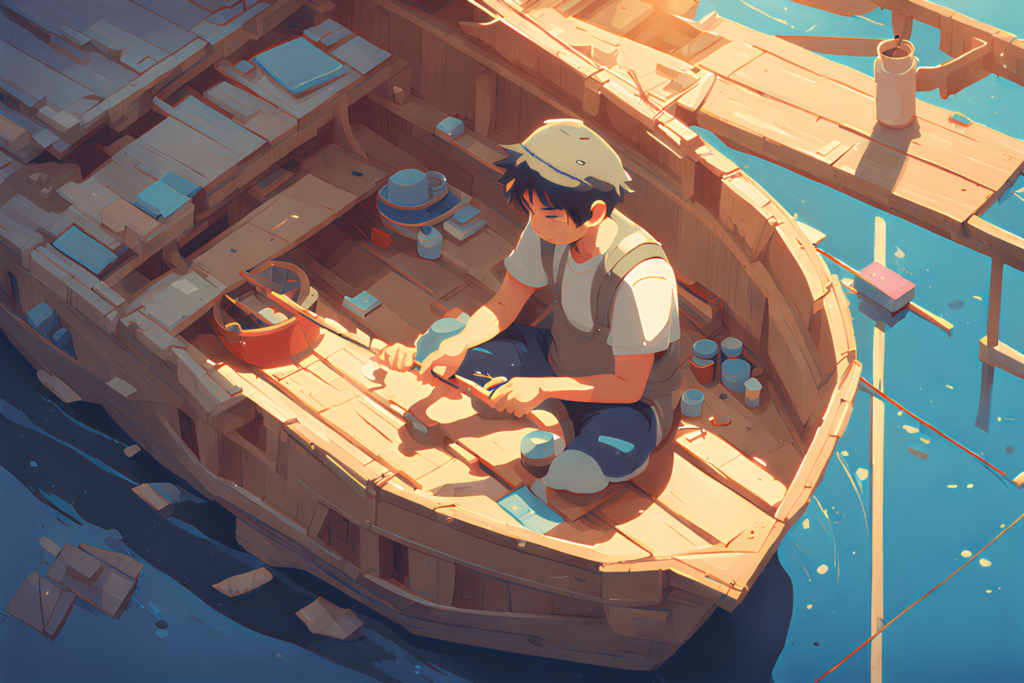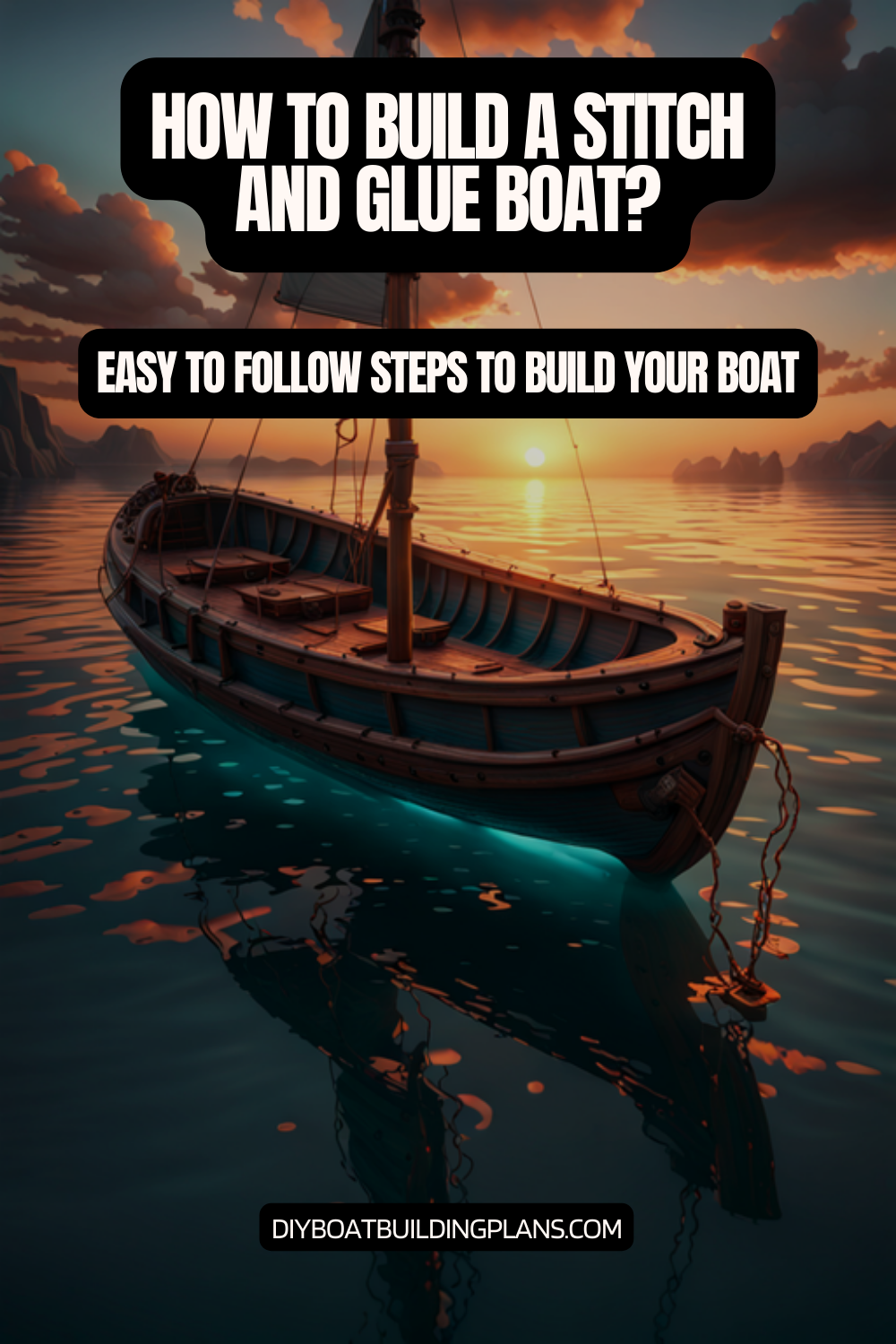Ever dreamed of making your own boat with plywood, epoxy, and determination? What if you could turn basic materials into a seaworthy vessel in your workshop?
DIY boat building with the stitch and glue method is exciting for woodworking fans and sea lovers. This method lets hobbyists make beautiful boats using simple steps and little special gear.
The stitch and glue method changes boat building by making it fast and easy. It doesn’t need a lot of skill, but it gives amazing results for those who love to craft.
Key Takeaways – How To Build a Stitch and Glue Boat
- Stitch and glue method simplifies boat construction process
- Minimal specialized tools required for project completion
- Affordable approach to creating personal watercraft
- Suitable for intermediate woodworking skill levels
- Offers flexibility in boat design and customization

Introduction to Stitch and Glue Boat Building
Explore the exciting world of DIY watercraft with stitch and glue boat building. This method turns simple plywood into amazing boats. It has fascinated hobbyists and boat lovers for years.
Stitch and glue boat building is a unique way to make boats. It uses plywood, wire, and special epoxy. This lets builders make everything from small kayaks to big sailboats.
What is a Stitch and Glue Boat?
A stitch and glue boat is made by:
- Cutting precise plywood panels
- Temporarily stitching panels together with wire
- Permanently bonding seams with marine-grade epoxy
- Reinforcing structure with fiberglass tape
“The beauty of stitch and glue lies in its accessibility and adaptability for boat building techniques.” – Traditional Boat Builder’s Manual
Benefits of Building Your Own Boat
Building your own boat with plywood has many benefits:
| Benefit | Description |
|---|---|
| Cost-Effectiveness | Complete boats under $300 with smart material shopping |
| Customization | Design boats tailored to personal specifications |
| Time Investment | Simple canoes and kayaks completed in less than 60 hours |
| Skill Development | Learn intricacies of boat building |
Stitch and glue boat building is for all, from small paddle craft to big 30-foot boats. Your dream boat is just a few stitches and epoxy joints away!
Tools and Materials Needed
Starting a stitch and glue boat project needs careful planning and the right supplies. Choosing the best materials and knowing their uses is key. It can make your build easier or harder.
Essential Tools for Your Boat Building Project
Having the right tools is vital for building a boat. Here are the must-haves:
- Sharp scissors for precise cutting
- Drill with various drill bits
- Power circular sander
- Coping and keyhole saws
- Disposable brushes
- Latex gloves
- Plastic scrapers
Selecting Marine-Grade Plywood
Picking the right plywood is key for a strong boat. Okoume marine-grade plywood is the best choice for builders. For fun boats, lauan is a good option too.
| Plywood Type | Thickness | Recommended Use |
|---|---|---|
| Okoume Marine Grade | 1/8 inch | Professional Boat Building |
| Lauan | 1/8 inch | Recreational Boats |
Epoxy Resin and Gluing Techniques
Epoxy resin is the heart of the stitch and glue method. You’ll need a 2:1 resin to hardener mix. Buy about one gallon of epoxy resin and half a gallon of hardener.
“Proper preparation and material selection are the keys to a successful boat building project.”
When working with epoxy resin, safety is a must. Wear:
- Safety glasses
- Respirator mask
- Chemical-resistant gloves
- Protective clothing
With the right tools, materials, and epoxy resin, you’re ready to start your boat building journey.
Designing Your Boat
Creating the perfect boat starts with smart design. You need to think carefully about boat design software and custom plans. Whether you want a sleek kayak or a practical fishing boat, knowing about design is key.
- Purpose of the boat (fishing, recreation, racing)
- Available workspace dimensions
- Personal skill level
- Budget constraints
Understanding Boat Plans
Kayak blueprints are essential for your boat-building journey. Professional designers offer plans for all skill levels. You can find these plans online, in places that specialize in boat design software and custom plans.
“The right plan transforms raw materials into a masterpiece of maritime engineering.” – Boat Design Expert
Adjusting Dimensions for Your Needs
Customization is important when using boat plans. Designers suggest starting with standard sizes and then making small changes. For example, you can make a 16-foot kayak into a 14-foot one by tweaking the bow and stern.
Choosing the Right Shape and Style
The shape of your boat affects its performance. Think about the hull design, water conditions, and use. Stitch and glue techniques let you adjust traditional designs to fit your needs.
- Flat-bottom designs for calm waters
- V-shaped hulls for rougher conditions
- Specialized kayak configurations
Pro tip: Always test-fit your design digitally before cutting any materials to save time and resources.
Unlock the secrets to building your dream boat with MyBoatPlans! With detailed plans for over 518 boats and expert video tutorials, you’ll have everything you need to create your perfect vessel. Click here to begin your journey!”
Preparing Your Workspace
Creating the perfect boat building workspace is key for a successful project. Your workspace sets the stage for your boat-building journey. It affects both the quality of your work and your experience.
Finding the right location is the first step. Look for a well-ventilated area with plenty of space. A spacious garage or outdoor workshop is ideal. Natural light and good air circulation are essential for boat construction.
Setting Up Your Boat Building Area
When designing your workspace, consider these important elements:
- Choose a flat, level surface for precise work
- Ensure adequate lighting to see fine details
- Maintain a clean, dust-free environment
- Create separate zones for cutting, epoxy work, and sanding
Workshop Safety Precautions
“Safety doesn’t happen by accident” – Unknown
Workshop safety is critical in boat building. Protect yourself with these essential safety measures:
- Wear protective gear: safety glasses, respirator, and gloves
- Keep a first aid kit readily accessible
- Install fire extinguishers in strategic locations
- Ensure proper ventilation when working with epoxy
Tool Organization Strategies
Effective tool organization makes your boat building process smoother. Invest in quality storage solutions. Pegboards, toolboxes, and dedicated shelving help keep your workspace efficient and tools protected.
Consider setting up a dedicated tool station. Use clearly labeled sections for different tools and materials. This method saves time and reduces the chance of losing important parts during your project.
Cutting the Plywood
Getting the plywood cut right is key for a successful stitch and glue boat. You need to measure carefully, cut smartly, and finish well. This ensures your boat is strong and performs well.
Measurement and Marking Techniques
Starting with accurate measurements is important. Here are some tips from the pros:
- Use a carpenter’s square for precise right-angle measurements
- Mark points every 24 inches along plywood edges
- Utilize a flexible batten for creating smooth curved lines
- Verify measurements multiple times before cutting
Best Practices for Cutting Plywood
Choosing the right tools for cutting is critical. Different saws are better for different cuts:
| Saw Type | Best Used For | Precision Level |
|---|---|---|
| Circular Saw | Straight cuts | High |
| Coping Saw | Curved lines | Medium |
| Japanese Pull Saw | Detailed cuts | Very High |
Tips for Smooth Edge Finishing
Finishing edges smoothly is vital for a pro-looking boat. Use 80-grit sandpaper to smooth out cut edges. This makes sure panels fit together perfectly.
Also, round the inside edges a bit. This helps panels fit better and reduces stress points.
“Patience and precision are the secrets to exceptional boat building.” – Experienced Boat Craftsman
Always wear protective gear like latex gloves when cutting and sanding. This keeps you safe while working on your boat.
Stitching the Panels Together
Assembling plywood panels is key in building a boat hull. It needs precision and careful technique. The wire stitching process turns separate plywood pieces into a solid boat structure. This is the base for a strong watercraft.
Building a stitch and glue boat requires special wire stitching techniques. These ensure panels fit perfectly. Skilled craftsmen use these methods to make a strong, smooth hull.
Overview of the Stitching Process
The wire stitching process has several important steps:
- Drill small holes about 1/2 inch from panel edges
- Space holes every 3-4 inches for best panel alignment
- Use 20-gauge solid copper wire or heavy-duty zip ties
- Keep initial connections loose for panel adjustment
Choosing the Right Stitching Method
The right wire stitching technique is vital for your boat. Experts suggest:
- Choose flexible wire for panel movement
- Twist wires carefully to avoid panel damage
- Make temporary but secure connections
*Precision in wire stitching is the key to a perfectly aligned boat hull.*
Tools for Stitching Plywood
Key tools for plywood panel assembly are:
- 20-gauge solid copper wire
- Heavy-duty zip ties
- Small drill with precise bit sizes
- Wire cutters
- Needle-nose pliers
By learning these wire stitching techniques, DIY boat builders can make a strong hull. This is the start of a great watercraft.
Applying Epoxy and Fiberglass
Building a stitch and glue boat needs careful epoxy application and fiberglass reinforcement. This stage turns your boat into a strong, ready-to-use vessel.
Epoxy application is key for boat hull strengthening. Professional builders know the right technique makes the boat durable and water-resistant.
Mixing and Preparing Epoxy
Starting with epoxy application means precise mixing. Here are the essential steps:
Download over 500 Boat Plans. Click on the link below.
-->Click Here<--
- Use the ratio recommended by the manufacturer
- Mix well for a consistent chemical reaction
- Work in a well-ventilated area with protective gear
- Keep the temperature consistent during mixing
Fiberglass Reinforcement Techniques
Fiberglass reinforcement adds vital strength to your boat hull. Applying fiberglass tape along seams makes the surface strong and seamless.
“A well-executed fiberglass layer is the difference between an amateur and professional boat build.” – Experienced Boat Builder
Tips for a Smooth Finish
For a professional finish, focus on details during epoxy application:
- Sand between epoxy layers for better adhesion
- Use a polypropylene drop cloth to minimize surface imperfections
- Apply thin, even coats of epoxy
- Remove air bubbles immediately after application
The stitch and glue method lets even beginners build a strong, lightweight boat. This is thanks to careful epoxy application and fiberglass reinforcement.
Adding Structural Support
Building a stitch and glue boat needs careful focus on its strength. The frame installation is key to making a sturdy boat. It turns your boat into a strong vessel for water adventures.
Installing Bulkheads and Frames
Bulkheads and frames are the heart of your boat’s strength. They add rigidity and spread out weight evenly. Here’s how to install bulkheads:
- Measure and mark precise bulkhead locations
- Cut bulkhead panels with exact dimensions
- Ensure tight fit against hull sides
- Use epoxy for secure attachment
Reinforcing the Hull
Reinforcing the hull keeps your boat’s shape and strength. The stitch-and-glue method lets you add strategic reinforcement. This boosts your boat’s performance.
Experts suggest these reinforcement methods:
- Add fiberglass tape along seams
- Apply multiple layers of marine-grade epoxy
- Install internal support beams
- Use marine plywood for maximum durability
Importance of Weight Distribution
Good weight distribution is key for a boat’s performance and stability. Where you place structural elements affects how your boat moves on water.
“A well-balanced boat is the mark of a skilled builder” – Traditional Boat Building Wisdom
| Structural Element | Purpose | Recommended Material |
|---|---|---|
| Bulkheads | Provide internal structure | Marine Plywood |
| Support Beams | Increase hull rigidity | Hardwood or Composite |
| Epoxy Layers | Waterproof and strengthen | Marine-Grade Epoxy Resin |
By focusing on frame installation, hull reinforcement, and structural support, you’ll make a beautiful and functional boat.
Sanding and Finishing
To turn your handcrafted boat into a stunning work of art, focus on sanding techniques and marine finishes. The last steps of wood boat painting can make your vessel look professional and ready for the water.
Sanding is key to getting your boat ready for a perfect finish. Experts say using a smart plan is essential for the best results.
Essential Boat Sanding Techniques
- Begin with coarse 60-grit sandpaper for leveling the surface
- Move to finer grits for a smooth finish
- Use hand sanding for small areas to avoid damage
- Always wear a dust mask and safety glasses
Choosing Marine Finishes
Picking the right marine finish depends on your boat’s use and look. Water-based stains are best with epoxy for strong adhesion and protection.
| Finish Type | Durability | Appearance | Best For |
|---|---|---|---|
| Varnish | High | Glossy, traditional | Wooden boat preservation |
| Marine Paint | Very High | Solid colors | Heavy-use boats |
| Epoxy Coating | Excellent | Clear, protective | Waterproofing |
Wood Boat Painting Tips
“The key to a perfect finish is patience and multiple thin coats,” says professional boat builder Mark Stevens.
- Sand between each coat for maximum smoothness
- Apply thin, even layers of marine finish
- Let each coat dry fully before adding more
- Check for any flaws before the final coat
Good sanding and finishing not only make your boat look great but also protect it from water and the elements.
Installing Hardware and Accessories
Building your stitch and glue boat needs careful picking and fitting of marine accessories. The right boat hardware makes your boat go from a simple hull to a ready-to-use watercraft.
Choosing the right marine accessories means knowing what you need for boating and what your boat can do.
Essential Hardware Selection
When you’re getting your boat ready, think about these important marine accessories:
- Stainless steel deck cleats for safe docking
- Waterproof deck plates for storing things
- Non-slip deck surfaces for safety
- Adjustable hiking straps for better sailing
Installing Deck Fixtures
Kayak outfitting needs precision and care. The right installation makes your boat last longer and work better.
- Measure and mark where to put fixtures carefully
- Use marine-grade sealant around all hardware
- Drill pilot holes to avoid wood splitting
- Countersink bolts for a smooth finish
Safety Feature Considerations
“A well-equipped boat is a safe boat.” – Nautical Wisdom
Important safety features include:
| Safety Accessory | Purpose |
|---|---|
| Grab Handles | Help with boarding and support in emergencies |
| Non-Skid Surfaces | Stop slipping in wet conditions |
| Flotation Devices | Keep the boat stable and provide emergency buoyancy |
Remember, proper boat hardware installation is key for both performance and safety. Take your time, choose quality marine-grade materials, and focus on secure, watertight fittings.
Launching Your Stitch and Glue Boat
After months of crafting, the moment of truth is here – launching your handmade boat. Proper preparation is key for a successful first-time boat test. It ensures water safety for your adventure.
Before you go to the water, do a final check on your boat. Look at every seal, fitting, and hull surface. This is to find any weaknesses or flaws that could affect safety.
Preparing for Launch Day
Choosing the right place for your boat’s first trip is important. Pick calm waters with little wind and waves. This helps you control the boat better during your first test.
- Bring essential safety equipment
- Inspect all structural connections
- Test boat stability near shore
- Have a support person present
Best Practices for First-Time Launch
Water safety starts with careful preparation. Begin by slowly getting into the water. Watch how your boat moves and look for any leaks or unexpected movements.
| Preparation Step | Key Actions |
|---|---|
| Pre-Launch Checklist | Hull inspection, seal verification |
| Safety Equipment | Life jacket, repair kit, communication device |
| Initial Testing | Stability check, leak detection |
Troubleshooting Common Issues
Be ready for minor problems during your first boat launch. Have repair materials ready and stay calm if small fixes are needed. Remember, every boat builder started where you are now, on their first exciting journey.
“The sea does not reward those who are too anxious, too greedy, or too impatient.” – Anne Davison

Maintenance and Care Tips
Keeping your boat in top shape is key to its long life and performance. Start with regular inspections to protect your investment. Look for wear on the epoxy coating, focusing on stress points like joints and decks.
After each trip, clean your boat well and check for damage. Boat care means checking for small cracks or weak spots in the plywood. Use marine-grade epoxy for quick fixes, making sure corners are rounded to avoid stress.
Storing your boat right is vital to prevent damage and keep it strong. Keep it in a cool, dry place out of the sun. If you must store it outside, use a cover that lets air through. Watch for moisture, mold, or pests. Wooden boats are sensitive to temperature and humidity, so consistent care is a must.
Make a seasonal maintenance plan with tasks like sanding, re-coating with marine epoxy, and checking hardware. Spending time on prevention can save you from expensive repairs later. With the right care, your handcrafted boat will give you many years of fun on the water.
FAQ – How To Build a Stitch and Glue Boat
What is the stitch and glue boat building method?
Stitch and glue boat building uses plywood panels cut to shape. They are stitched together with wire or zip ties. Then, marine-grade epoxy and fiberglass tape bond them permanently. This method is great for making many types of boats, from kayaks to sailboats. It’s affordable and lets you customize your boat.
What materials do I need to build a stitch and glue boat?
You’ll need marine-grade plywood, epoxy resin, fiberglass tape, and basic tools. Tools include a saw, drill, and epoxy brush. Safety gear like gloves, eye protection, and dust masks is also essential. Use high-quality materials that can handle water.
How difficult is it to build a stitch and glue boat for a beginner?
Building a stitch and glue boat is doable for beginners. It needs patience and attention to detail. Following plans, watching tutorials, and taking your time helps. Starting with a small project like a kayak is a good way to begin.
Where can I find boat plans for stitch and glue construction?
You can find boat plans online from places like Chesapeake Light Craft and Pygmy Boats. Free plans are also available for designs like the Guillemot. For custom designs, use software like FreeShip or DelftShip.
How long does it take to build a stitch and glue boat?
Building time varies by boat size and your skill level. A small kayak might take 100-200 hours. Larger boats can take months. Work in stages and consistently to manage the time better.
What are the main advantages of stitch and glue boat building?
This method is cost-effective and allows for customization. Building your own boat is rewarding. It’s also a simple process that results in a strong, lightweight boat.
How much does it cost to build a stitch and glue boat?
Costs range from $500 to $3,000, depending on the boat size and materials. A small kayak might cost $500-$1,000. Larger boats can cost up to $3,000. This is cheaper than buying a pre-made boat.
What safety precautions should I take when building a stitch and glue boat?
Work in a well-ventilated area and wear protective gear. Follow instructions carefully. Keep your workspace clean and safe. Take your time and don’t rush.



